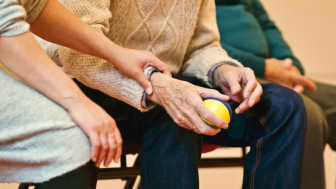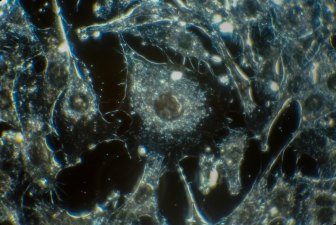10 Things You Need to Know About Lung Cancer
Last updated: 30 October 2018

You can legally access new medicines, even if they are not approved in your country.
Learn how
In 2015, an estimated 221,200 people in the U.S. will be diagnosed with lung cancer, which is 13 percent of all cancer diagnoses.1
Though it is the most common cancer in the world and the leading cause of cancer-related deaths in the U.S.,2 early diagnosis, the ongoing development of promising medications, and increasing awareness of risk factors associated with it could help the death rate to decline.
Although many new medicines for the treatment of lung cancer have been approved in recent years, there may still be delays in access for patients, hospitals and doctors in some countries. There can be multiple factors that contribute to these delays such as market authorisation and bureaucratic delays. If you or a loved one is interested in sourcing a medicine not yet available in your country, you can visit our home page for more information around how this can be done, what you’ll need to do it, and how our team can guide you through the process. Our team delivers not yet approved medicines from around the world on daily basis, with service that’s highly rated by doctors and patients.
Here are 10 things you need to know about lung cancer.
1. Lung cancer symptoms
Early-stage lung cancer is often symptomless, making it difficult for an early diagnosis. But as it progresses, some common symptoms arise, including the list below. This is by no means a complete list of symptoms. If you have any worries or cause for concern, always speak to your doctor without delay.
- A cough that doesn’t go away or gets progressively worse
- Fatigue or weakness
- Shortness of breath
- Chest pain that is often noticed when breathing, laughing or coughing
- Hoarseness
- Coughing up blood
- Development of bronchitis and/or pneumonia that doesn’t get better
- Loss of appetite
- Weight loss
If lung cancer spreads, other symptoms may emerge, such as:
- Jaundice (yellowing of the skin and eyes)
- Swollen lymph nodes or lumps under the skin
- Back or hip pain
- Nervous system problems: headaches, dizziness, arm or leg weakness, or seizures
2. There are two major types of lung cancer
These are; non-small cell lung cancer (NSCLC) and small cell lung cancer (SCLC).
Approximately 85 to 90 percent of diagnosed lung cancers are NSCLC, and there are three types of these3:
- Adenocarcinoma: This cancer is most commonly found in current or former smokers. However, it is also the most common lung cancer found in non-smokers, is more common in women than in men, and more likely to develop in younger people than any other forms of lung cancer. Approximately 40 percent of lung cancers are adenocarcinomas.5 This cancer typically develops in the outer layers of the lungs, tends to grow slower than other forms, and has a greater chance of being found before it spreads to other areas.
- Squamous cell (epidermoid) carcinoma: These are often linked to smoking and develop within the inner airways of the lungs. Around 25 to 30 percent of lung cancers are squamous cell carcinomas.4
- Large cell (undifferentiated) carcinoma: This cancer can develop in any area of the lung and accounts for around 10 to 15 percent of lung cancer.6 It typically grows quickly and spreads fast, which makes it harder to treat.
- Small cell lung cancer
Small cell lung cancer (SCLC) and sometimes also called by its other name Oat Cell Cancer accounts for approximately 10 to 15 percent of all lung cancers and very rarely develops in someone who has not smoked.7 SCLC develops in the chest—usually in one part of the lung—and then typically spreads quickly through the rest of the body.
3. Lung cancer affects non-smokers, too
Though the greatest risk factor for lung cancer is smoking, approximately 10 to 15 percent of cases occur in non-smokers.8 This means that approximately 16,000 to 24,000 Americans who have never smoked die from lung cancer each year.9
Second-hand smoke is the third leading cause of lung cancer and has been found to increase a person’s risk “with the extent of exposure determining the associated risk,” according to Dr. Megan Baumgart, an assistant professor in the department of medicine, hematology/oncology at the Wilmot Cancer Institute in Rochester, New York.
Each year, 7,000 adults die from second-hand smoke.10 Those who live with a smoker or who are exposed to it in the workplace are at a 20 to 30 percent increased risk of developing lung cancer.11 In fact, if lung cancer in non-smokers was considered its own category, it would rank in the top 10 deadly cancers in the U.S.12
Laws that ban public smoking have helped to reduce the danger, and organizations such as the American Cancer Society Cancer Action Network are working to strengthen such laws.
4. Environmental factors
Radon gas is the number one cause of lung cancer in non-smokers, accounting for 21,000 deaths each year.13 This odorless, tasteless gas occurs in nature and is normally harmless; however, it can become concentrated within homes that are constructed in soil with uranium deposits. The only way to determine whether it exists in high levels within a home is to test for it.
Air pollution was designated a cancer-causing agent in 2013 by the World Health Organization. In the U.S., however, the risk of developing lung cancer due to air pollution is smaller than in other countries due to environmental policies.
Other environmental factors that increase the risk for lung cancer include exposure to asbestos, arsenic, tar, soot, chromium and nickel. Inflammation, most commonly caused by foods such as white bread and sugar-laden products, has also been found to be a contributing risk factor.
5. Screening could benefit high-risk cases
Though new screening techniques are being developed that aim to diagnose lung cancer in its earlier stages, current screening won’t typically prevent lung cancer from developing unless a person is considered high risk. High-risk people, according to the U.S. Preventive Services Task Force (USPSTF), are:
- Current smokers or smokers who quit within the past 15 years
- And who are 55 to 80 years old
- And have smoked at least one pack of cigarettes each day for 30 years or two packs a day for 15 years
For these smokers or former smokers, annual screenings with a low-dose CT scan (LDCT) can prevent a significant number of “lung-cancer-related deaths.”
6. Lung cancer is treatable when caught early
Treatment for lung cancer depends on several factors such as the type of cancer, where the tumours are located, the stage of cancer, and the patient’s overall health.
When lung cancer is diagnosed in its early stages, long-term survival rates increase. But because symptoms typically do not develop until later, it is often difficult to make a correct diagnosis until the cancer is in an advanced stage. The five-year survival rate for cases in which the cancer is found early—when it is still confined to the lungs— is 52 percent.14 Once it has spread to other organs, however, the survival rate falls to just four percent.15
Early-stage non-small cell lung cancer—a form that is most commonly caused by smoking—has a better prognosis than other forms through the use of surgery or radiation therapy.
Clinical trials are ongoing throughout most of the U.S. and the National Cancer Institute encourages anyone diagnosed with lung cancer to consider participating, particularly those who have been diagnosed with non-small cell lung cancer.
7. Positive results from new medications
During the last decade, new, targeted therapies, treatments that focus on specific irregularities within the tumours themselves, have begun to show promise. Some of these include bevacizumab (Avastin), which stops tumours from forming a new blood supply; and erlotinib (Tarceva), which prevents chemicals from telling cancer cells to multiply.
Immunotherapy drugs—drugs that help the immune system reboot and fight cancer—are another new medication showing promise, and “side effects could be more favorable than chemotherapy drugs,” Dr. Eric S. Kim, an assistant professor in the department of medicine, hematology/oncology at the Wilmot Cancer Institute in Rochester, New York, said in an April 2015 interview with Live Science.
The latest of these medications to be approved by the FDA is nivolumab (Opdivo), which targets two sub-types of non-small cell lung cancer called metastatic nonsquamous non-small cell lung cancer (NSCLC) and metastatic squamous NSCLC that have continued to progress despite chemotherapy.
In a recent international clinical trial, 19 percent of the 582 participants responded to Opdivo compared to a 12-percent response rate to the cancer drug docetaxel.16 Median overall survival rate for those treated with Opdivo was 12.2 months, compared to 9.4 months for those receiving docetaxel.17
Proton therapy, which delivers precise radiation to a specific tumour so that healthy tissue is not affected, has also shown significant promise in the treatment of lung cancer, especially late-stage NSCLC.
For more detailed information about the results of new medicines, visit the lung cancer medicines page.
8. It’s never too late to quit smoking
Smoking is the number one cause of lung cancer, and this doesn’t just mean cigarettes. Cigars and pipes also contain the chemicals that can damage cells and cause cancer. The best way to prevent lung cancer is to never start smoking, or to quit if you do.
Smoking contributes to 90 percent and 80 percent of deaths in men and women respectively.18 Men who smoke are 23 times more likely to develop lung cancer; women who smoke are 13 times more likely.19 Between 2005 and 2010, approximately 131,000 Americans died of smoking-related lung cancer each year.20
The risk of lung cancer begins to fall within weeks or months for those who choose to quit smoking. Remaining a non-smoker for at least 10 to 20 years cuts the risk of developing lung cancer by 50 to 75 percent.21
9. Support groups for lung cancer patients, their families and friends
More than 430,000 people living today have at some point been diagnosed with lung cancer.22 Seeking support from others, including professionals, is an important step. Support groups exist across the U.S.—both professional and peer—and are open to anyone diagnosed with lung cancer.
Palliative care specialists can also provide support after a diagnosis. A common misconception is that palliative care is for end-of-life care but when used alongside treatment, it has actually been found to extend life.
10. Raising awareness through social media
There are many ways to become involved with the fight against lung cancer. Raise awareness via Facebook and Twitter with messages that aim to make a difference. Join the conversation on lung cancer at #lcsm and learn about events, new clinical trials, and treatments. Other key hashtags are #ShineALight, and #lungcancer.
Shine a Light on Lung Cancer, which is the largest awareness event for lung cancer, takes place every year, as well as Team Lung Love, coordinated sports events that range from 5Ks to triathlons.
Connect with others through Lungevity, which provides a platform of resources, support, survivorship programs and events across the country for people diagnosed with lung cancer, as well as their families, friends, and healthcare providers.




